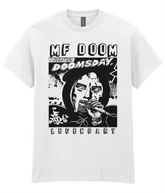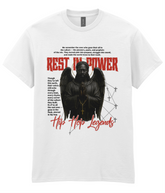The Story of Wu-Tang Clan: From Shaolin to Hip-Hop Immortality
The Story of Wu-Tang Clan: From Shaolin to Hip-Hop Immortality
Enter the Wu-Tang: The Beginnings
Back in the early ‘90s, when rap was bubbling with raw energy, a group of nine fearless emcees from Staten Island (aka Shaolin) emerged like hip-hop warriors with a mission: to take over the rap game, one Shaolin sword strike at a time. Their leader, RZA, had a vision—an underground, martial arts-inspired empire built on razor-sharp lyricism, gritty beats, and a brotherhood tighter than a kung fu grip.

The squad consisted of RZA, GZA, Ol’ Dirty Bastard, Method Man, Raekwon, Ghostface Killah, Inspectah Deck, U-God, and Masta Killa. Together, they formed the Wu-Tang Clan, a name inspired by the legendary Shaolin and Wu-Tang kung fu flicks. But before their major label success, they started out as true hip-hop hustlers, selling their first single, Protect Ya Neck, independently. With no major label backing, they pressed and distributed the record themselves, grinding through local radio stations and mixtape circuits. Their hard work paid off, catching the attention of Loud Records, a then-underground label that gave them full creative control.
Deeply influenced by the teachings of the Five-Percent Nation, many Wu-Tang members infused their rhymes with knowledge of self, supreme mathematics, and spiritual wisdom, blending street poetry with philosophical depth. This unique approach set them apart, making their music feel more like a movement than just another rap act.
In 1993, their groundbreaking debut album Enter the Wu-Tang (36 Chambers) dropped, introducing the world to their raw, unfiltered style. The production was gritty, the lyrics were razor-sharp, and the chemistry was undeniable. Hip-hop was never the same again.

Interesting Wu-Fact #1:
The Clan’s unique deal let members sign solo contracts with different labels while staying united under the Wu-Tang umbrella. This was unheard of in the industry and turned out to be a genius power move!
Interesting Wu-Fact #2:
Ol’ Dirty Bastard once took a limo to pick up food stamps. No, seriously. A full-blown limousine. With cameras rolling. Because why not?
The Solo Reign: Wu-Tang’s Dynasty Expands
After shaking up the rap world as a collective, the Clan members wasted no time in dropping classic solo albums. First up was Method Man’s Tical (1994), featuring the smoky anthem “Bring the Pain.” Then came Raekwon’s Only Built 4 Cuban Linx… (1995), also known as "The Purple Tape" due to its unique cassette color. This album was the blueprint for mafioso rap and featured Ghostface Killah heavily, solidifying their chemistry as a duo.
GZA’s Liquid Swords (1995) took a more cerebral approach, with cold, calculated lyricism over haunting RZA beats, making it one of the most lyrically dense projects in hip-hop history. Meanwhile, Ghostface Killah’s Ironman (1996) showcased his emotional storytelling, often delivered behind a signature mask he wore early in his career due to legal issues.
Ol’ Dirty Bastard’s Return to the 36 Chambers: The Dirty Version (1995) was as wild and unpredictable as the man himself, bringing a raw energy that only he could deliver. Inspectah Deck was set to have his own breakout moment, but a devastating flood in RZA’s basement wiped out his original album recordings, delaying his solo debut for years.
Meanwhile, RZA introduced the world to his alter ego, Bobby Digital, a futuristic, experimental persona that pushed the sonic boundaries of hip-hop. His Bobby Digital in Stereo (1998) was a blend of distorted beats, digital effects, and RZA’s signature gritty flow, showcasing his versatility as a producer and artist.
During this era, the Wu-Tang Clan also introduced Cappadonna, an unofficial tenth member who had been affiliated with the group since the early days. Cappadonna made his mark with a standout verse on “Ice Cream” from Only Built 4 Cuban Linx… and was later heavily featured on Wu-Tang Forever before releasing his solo debut The Pillage in 1998.

Wu-Tang is Forever
By the time Wu-Tang Forever dropped in 1997, the Clan had already cemented their legacy. The double album went platinum multiple times over, proving that Wu-Tang wasn’t just for the streets—it was a worldwide phenomenon. The Clan also expanded their empire with spin-off groups like Killarmy and Sunz of Man, who carried the Wu-Tang torch with their own unique sounds. Gravediggaz, a supergroup featuring RZA, dabbled in "horrorcore" rap, bringing dark, eerie themes to the forefront. Even young Shyheim, "The Rugged Child," made a name for himself as Wu-Tang’s youngest affiliate.
Through trials, tribulations, and the tragic loss of Ol’ Dirty Bastard in 2004, Wu-Tang Clan remained an unstoppable force. ODB’s passing was a heartbreaking moment for hip-hop, as he was not just a wild performer but a true embodiment of the Wu-Tang spirit—unapologetic, raw, and larger than life.
Even decades later, Wu-Tang’s influence can be heard in generations of artists. Their iconic "W" logo remains one of the most recognizable symbols in music history, and their legacy? Untouchable.
Wu-Tang Clan ain’t nothin’ to mess with—and that’s a fact.





